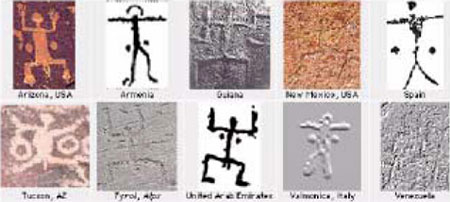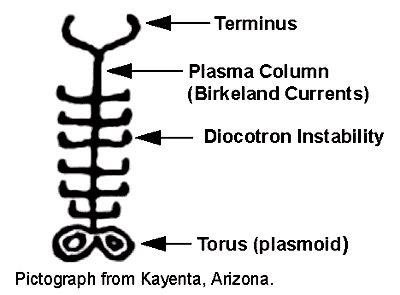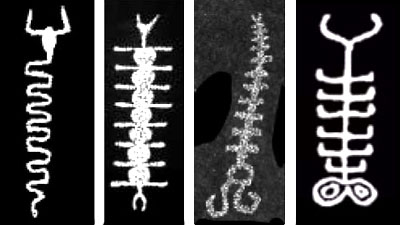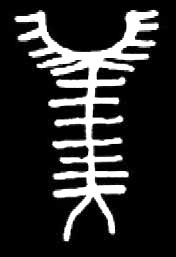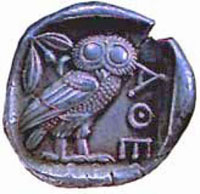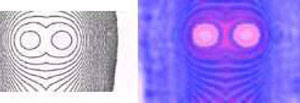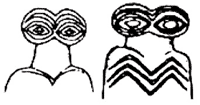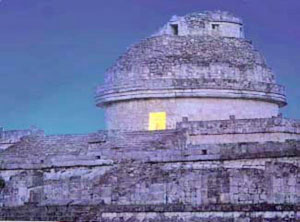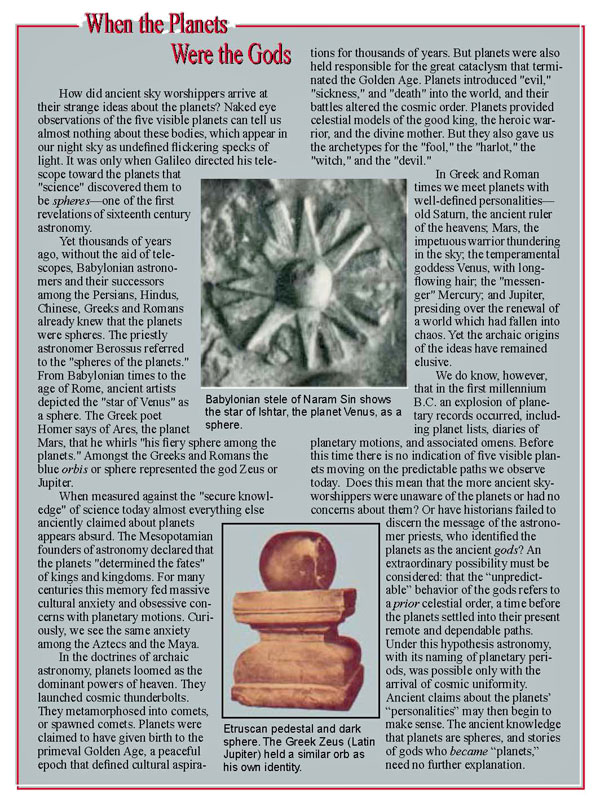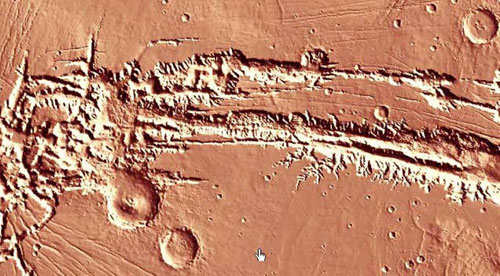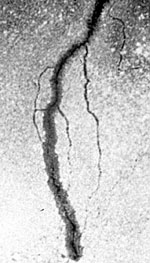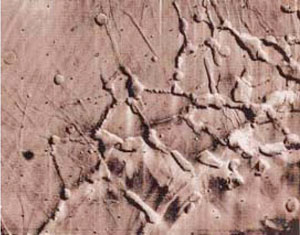|
CHAPTER ONE CONVERGENCE
carrying a lightning bolt in his right hand and a staff in his left.
Around his body
entwines the cosmic serpent, the prototype of the mythic dragon.
The Lens of Human Perception
Only a few decades ago, all well-trained, feet-on-the-ground scientists “knew” that:
Before new findings disproved these beliefs, they were so "obviously true" as to discourage challenges.
It is easy to confuse
theoretical assumption with fact, and today this tendency
often conceals a tacit belief that, despite the mistakes of
previous generations, we have the big picture right and the
remaining task is simply to tidy things up a bit.
The monstrous Tarantula Nebula, named for its many spidery filaments, is one of innumerable pointers to magnetic fields in space, the result of electric currents.
The actual situation in the sciences calls for openness to new possibilities.
Our vision of the universe is changing more rapidly than ever before, as space exploration fuels an explosion of discovery. Before the advent of the space age, we could view the electromagnetic spectrum and into infrared, microwave, and radio in the long wavelengths.
We can view at close range the surfaces of planets, moons, asteroids and comets.
We can even touch and chemically "taste" them.
The new discoveries accent the unexpected - a sign that something is wrong at the level of theoretical assumptions.
In fact, two of the most far-reaching discoveries of the past century came as great surprises: the pervasive role of charged particles or plasma in the universe; and the signature of cosmic catastrophe throughout our solar system.
The "big picture" of space has changed.
A logarithmic chart of
the electromagnetic spectrum reveals how narrow is the range of
visible light.
With this assumption they ignored a much more powerful agent in the universe - electricity. A crescendo of evidence reviewed in this volume (and those to follow) suggests that distant stars, our Sun, and the planets are electrically charged bodies. We now know that the visible universe, except for the Earth and a few rocky planets, moons and wandering solid objects, is composed of highly conductive plasma, a form of matter superficially similar to a gas but containing positively and negatively charged particles.
A gas will not react to or generate electromagnetic forces. But a plasma will.
So their models for the evolution of cosmic structure deal only with gravity.
But precise electrical neutrality throughout the universe is not a fact, it’s a precarious assumption.
If the assumption is wrong, the electric force can hardly be ignored: it is much stronger and more versatile than gravity. Gravity has only one mode for organizing matter - that of attraction. The electric force can attract or repel.
In addition, electromagnetic attraction in a current-carrying plasma declines linearly with distance from the axis of the current, while gravity declines more rapidly, with the square of distance.
In any attempt to understand the new data from space, these considerations become vital.
Because plasma exhibits characteristics not found in solids, liquids, or gases, it has been called "the fourth state of matter" or "the fundamental state of matter." It can self-organize into cells of differing electrical characteristics. Electric currents in plasma form filaments that attract each other at long distances and repel each other at short distances.
These filaments tend to braid themselves into "ropes" that act as power transmission lines, with virtually no limit to the distances over which they can operate.
A portrait of the center of our Milky Way galaxy constructed from radio data. NASA spokesmen note "the arcs, threads, and filaments which abound in the scene. Their uncertain origins challenge present theories of the dynamics of the galactic center." Arcs, threads and filaments are typical forms of electrical discharge in plasma.
In the rarefied plasma of space, the subtle flow of electricity is not easily measured, but these currents leave a definitive signature - a network of magnetic fields throughout the observed universe.
Astronomers detect these fields but give no attention to the electrical cause: magnetic fields are produced only by electricity. The complex magnetic fields we observe are evidence that plasma is carrying electrical energy across galactic and intergalactic space, powering and organizing secondary systems, including galaxies, stars, and planets.
Exceedingly subtle charge imbalances, across the immense volume of space, are quite sufficient to configure and animate cosmic structures at all scales of observation.
To see the connection between plasma experiments and plasma formations in space, it is essential to understand the scalability of plasma phenomena. Under similar conditions, plasma discharge will produce the same formations irrespective of the size of the event.
Solar prominences reveal the powerful influence of magnetic fields. However, magnetic fields require electric currents, and the fields alone do not cause the prominences. The picture above is direct evidence of electrical discharge on the Sun.
The same basic patterns will be seen at laboratory, planetary, stellar, and galactic levels.
Duration is proportional to size as well. A spark that lasts for microseconds in the laboratory may continue for years at planetary or stellar scales, or for millions of years at galactic or intergalactic scales.
Many of astronomy’s most fundamental mysteries find their resolution in plasma behavior. Why do cosmic bodies spin, asked the distinguished astronomer Fred Hoyle, in summarizing the unanswered questions. Plasma experiments show that rotation is a natural function of interacting currents in plasma. Currents can pinch matter together to form rotating stars and galaxies. A good example is the ubiquitous spiral galaxy, a predictable configuration of a cosmic-scale discharge.
Computer models of two current filaments interacting in a plasma have, in fact, reproduced fine details of spiral galaxies, where the gravitational schools must rely on invisible matter arbitrarily placed wherever it is needed to make their models "work."
It is worth noting also that plasma experiments, backed by computer simulations of plasma discharge, can produce galactic structures without recourse to a popular fiction of modern astrophysics - the Black Hole.
Astronomers require invisible, super-compressed matter as the center of galaxies because without Black Holes gravitational equations cannot account for observed movement and compact energetic activity.
But charged plasma achieves such effects routinely.
Spiral galaxy M81, in
one of the first images returned by NASA’s new Spitzer space
telescope.
Planets, Comets, and Plasma Discharge
Astronomers do not recognize planetary charge because the planets now move on nearly circular orbits. The change in electric potential during a revolution is so minimal as to produce no obvious effects. (We take up the subtle indicators of planetary circuits in our discussion of auroras, weather patterns, lightning, dust devils, and tornadoes in Chapter V.)
Plasma will form a cell, or "sheath," around any object within it that has a different electric potential. If the potential difference is low, the plasma sheath will be invisible. This is the case with the planets, whose plasma sheaths are called "magnetospheres" because the planetary magnetic field is trapped inside. Unlike a planet, however, a comet, spends most of its time far from the Sun and takes on a charge in balance with that region of the Sun’s electric field.
As it speeds toward the Sun, its charge is increasingly out of balance with its surroundings.
Eventually, the plasma sheath glows in response to the electric stresses.
This is what we see as the coma and ion tail of a comet. The dust tail is formed when more intense discharge - in the form of an electric arc to the comet nucleus - removes surface material and launches it into space.
The internal electric stress may even blow the comet apart, as often and "inexplicably" occurs.
Our claim that comets are electrical in nature can be easily tested. The standard model of comets explains them as "dirty snowballs" sublimating under the heat of the Sun.
Escaping water vapor generates the coma and is "blown" away by the solar wind to produce the diffuse tail. In the electrical model a large rock on an elliptical orbit - and containing no volatiles (ices) to evaporate - will still generate a coma and tail from the surrounding plasma in response to the voltage difference.
Photograph of the comet Hale Bopp, taken April 7, 1997 as it receded from the Sun, passing in front of a star cluster in the constellation Perseus. In addition to the dust tail of the comet, the filamentary bluish ion tail (positively charged particles) testifies to electrical behavior of comets only recently recognized.
To decide the issue, therefore, we ask the question: are comet nuclei "wet" or "dry"?
The spacecraft Deep Space 1 has already answered the question: As it flew by the nucleus of Comet Borrelly, it found the surface was "hot and dry." With no other model but that of the dirty snowball, astronomers could only assume that water must be present, but hidden inside the comet!
Then, NASA’s Stardust probe to comet Wild-2 startled investigators with its sharply defined and "completely unexpected" craters, suggesting a rocky body that challenged the entire concept of sublimating cometary snowballs.
What would have happened gravitationally and electrically if planets formerly moved on paths that induced high-energy discharge? And how might we know about such events, or determine with a measure of reliability when they occurred?
Electrical principles will not just change our ideas about gravity and planetary stability. They will also affect what we see and hear in messages from our early ancestors. Over the past century and a half, archaeologists have unearthed huge libraries of ancient texts, many of them describing great spectacles in the heavens.
But the specialists set aside these descriptions as "untrustworthy" because they accept a priori the clockwork solar system assumed by astronomers.
UPPER: Greek Zeus launching his far-famed thunderbolt.
LOWER:
Tibetan Dorje, the divine thunderbolt.
Historians do not doubt that the ancient sky looked almost exactly like our sky today. Consequently, they give little or no attention to the "extravagant" or "nonsensical" claims of early sky worshippers.
Allow intense plasma activity into the picture, however, and the ancient images begin to make sense. The sky was a theater of awe and terror: on this the witnesses of antiquity speak with one voice.
Though presented in the language of myth and symbol, ancient accounts are filled with images of electricity in a terrifying form - as the lightning bolt wielded by gods and heroes.
The "thunderbolts of the
gods" defy every effort to understand them as references to familiar
lightning. They spiral and whirl and entwine. They blossom as a
flower, or stand as a great pillar supporting the sky.
Called the "lotus form," it looks like an elongated football with spiral threads. Tibetans molded the gods’ thunderbolt into the form of a short double trident or scepter, which lamas hold during prayer.
These forms resemble the shapes taken by electric discharge in a near-vacuum.
But a much different understanding of ancient accounts is possible, if we grant to the original witnesses a certain integrity. We do not need to regard their testimony as "scientifically accurate."
We need only acknowledge that the core themes of mythology may have originated in extraordinary natural events, for which ancient races had no cultural preparation.
If this was the case, the stories are a form of historic testimony in the only languages that were available to the eyewitnesses themselves. It then becomes clear that around the world many different hieroglyphs and symbols actually described identical celestial phenomena. This discovery, in turn, requires that we follow logical rules for dealing with converging testimony.
How do we uncover the forgotten events now hidden behind the different symbols they inspired?
What was the
cosmic serpent or dragon so universally feared in
In our surveys of archaic gods and monsters, we discover that the points of cross-cultural agreement defy every attempt to trivialize them - not because the ancient images are scientifically impressive, but because the same outlandish images recur from one culture to another.
Consider, for example, the chaos monsters of the archaic cultures - such serpents or dragons as the Babylonian Tiamat, the Egyptian Apep, or the Greek Typhon - said to have attacked and devastated the world.
Neither these enemies of cosmic order, nor the gods they opposed, nor the far-famed "thunderbolts" displayed in these encounters trace to anything experienced in our time. The gods not only vanquish cosmic serpents and winged monsters with their thunderbolts; they blast each other with lightning in earthshaking conflagrations. Such themes lie at the heart of every culture’s mythology.
But universal mythology does not answer to our familiar world.
For more than a quarter century they labored in separate fields: David Talbott pursued a comparative study of ancient cultural themes, while Wallace Thornhill investigated the role of electricity in the universe and in solar system evolution. The authors presented their work together for the first time at a conference (organized by Dave) in Portland, Oregon, in 1994. Inspired by the common ground they shared, they began to explore the convergence further.
In December 1996 Wal again flew to Portland from Canberra, Australia, in advance of a January 1997 conference on "The Recent History of the Solar System." He camped out in Dave’s office and for four weeks the two compared notes.
He concluded that these patterns reflect celestial events no longer occurring. Though other students of comparative religion and mythology had noticed many of the themes, no one could explain them consistently in terms of familiar natural phenomena. Yet the global themes, Dave realized, are consistent with an unfamiliar celestial order, one involving planets, our Earth included, moving in close congregation.
He envisioned an ancient assembly of planets and moons, with interactions between nearby bodies producing animated and often symmetrical arrangements of dust and glowing gas that stretched across the sky of earthbound witnesses.
TOP: David Talbott’s book, The Saturn Myth (Doubleday, 1980) proposed that a former planetary configuration close to the earth inspired the archetypes of world mythology. BOTTOM: Wallace Thornhill’s CD, The Electric Universe (1998), suggested that electrical forces once dominated solar system evolution.
Though gravitational dynamics could not explain the model, Dave believed the cross-cultural evidence to be definitive, and he suspected the formations could be explained by electromagnetism.
But
he knew nothing of plasma behavior, having restricted his primary
research to the points of agreement between the ancient cultures. By
1997 he had produced more than three dozen "snapshots" of an
evolving, sometimes stable, but often violently unstable,
configuration of planets appearing gigantic in the heavens. Meanwhile, Wal had been documenting evidence for electrical interactions between planets in prehistoric times, seeking to reconcile plasma science and planetary geology with the human testimony gathered by other researchers. When he saw Dave’s reconstructed images, he recognized them as plasma discharge structures.
He showed Dave an image of a radial discharge from a plasma focus device (photograph below right) that matched Dave’s own reconstructions.
The dynamics of the plasma focus device resolved several paradoxes that had frustrated Dave for more than twenty years.
What gave the luminous streamers - radiating from the center of the con-figuration - their unusual symmetry? Why were there sometimes three streamers and at other times four or eight, or more? Why did the streamers sometimes curl into a triskeleon, swastika, or whorl? And why did they take on the appearance of wildly disheveled "hair" in periods of celestial disorder?
The various forms of discharge from the plasma focus answered each question. The repulsive force between the individual streamers will spread them into symmetrically spaced equilibrium positions. As the intensity of the discharge grows, so do the number of streamers.
And though the physics of the plasma focus device is simple, the interplay of electric and magnetic fields can become complex, often with the result that the streamers undulate and twist into more elaborate forms.
Selected “snapshots” of the hypothesized planetary configuration, based on images from the documentary,
“Remembering the End of the World” and
David Tal-bott’s conference slide presentations.
Plasma Cosmology - The Leading Edge of Science
Yet they were confident that openings for theoretical reconciliation were possible through the vision of several scientific trailblazers. One innovator of great interest to both researchers was engineer Ralph Juergens.
His groundbreaking work on the "electric sun" and on the electrical scarring of planets, though largely ignored for more than three decades, adds direct support to the hypothesis presented in these pages. Juergens himself was inspired by Dr. Charles Bruce of the Electrical Research Association in England, who observed that the Sun’s photosphere behaved in the fashion of an electric arc.
If the Sun is powered electrically, as claimed by Juergens, then standard theories of star formation and solar system evolution must be corrected at the level of fundamental assumptions.
Birkeland’s experiments early in the twentieth century showed how current filaments in plasma join in entwined pairs, now called “Birkeland currents.” Langmuir’s experimental work gave rise to the word "plasma," due to the life-like behavior of this conductive medium. He demonstrated how the plasma sheath insulates a charged sphere from its plasma environment.
This sheath is now crucial to the understanding of the so-called "magnetospheres" of planets, though few astronomers take into account the electrical implications.
From graduate school until Alfvén’s death in 1995, Peratt worked with the pioneer to define the frontiers of plasma cosmology, a subject highlighted in Eric Lerner’s popular book, The Big Bang Never Happened.
His work included unprecedented three-dimensional simulations of galaxy evolution and of other plasma structures in space. Today he is internationally recognized as an authority on plasma discharge instabilities and their three-dimensional simulation.
His "Particle in Cell" (PIC) simulations have produced formations that are virtually indistinguishable from the energetic patterns of actual galaxies, as can be seen below.
Peratt’s book The Physics of the Plasma Universe has led the way to a new understanding of the mathematics of plasma behavior and the role of electricity in the cosmos.
Due in large part to the Coalition of Plasma Science, of which Peratt is a member, the Institute of Electrical and Electronics Engineers, the world’s largest scientific and technical society, announced that it would recognize “Plasma Cosmology” as an official discipline in science.
Soon his retirement from teaching became a full-time exploration of the "The Electric Cosmos" (the title of his recently completed book). Scott contends in his book that the gravitational doctrines of modern astronomy must give way to a new theoretical framework honoring electricity as the more fundamental force in the heavens.
He writes:
Scott quickly emerged as a key consultant to Dave and Wal, with a deep personal interest in the historical reconstruction.
It was this interest that led him to contact Anthony Peratt, enabling Dave to follow up with a personal phone call. Dave showed Peratt a wide range of petroglyph themes. Peratt was intrigued by the striking similarities to plasma discharge formations, and he began his own investigation of rock art.
Many of the configurations had never been documented prior to this work; Peratt simply named them according to their configurations such as the "Christmas Tree instability". In this book we shall categorize these forms (now numbering over 80) as "Peratt Instabilities."
The key, Dave believed, would be the enigmatic images drawn on stone from prehistoric times onward. If early man witnessed awe-inspiring electrical phenomena on a scale immeasurably greater than a regional lightning storm, then surely the most direct source of information would be literal drawings of the formations. Over many years, Dave had catalogued dozens of patterns, but not all of them made sense, either to Dave or to Wal. Yet many of the patterns and associations could be confirmed around the world.
A flurry of communications followed, in which Dave sent to Peratt examples of widely-distributed rock art themes, and Peratt responded by identifying their place in the laboratory discharge sequence.
Because the lower-energy forms of plasma discharge can be seen in present-day auroras, Peratt wondered if the ancient artists may have witnessed an episode of high-energy plasma incursion into Earth’s atmosphere, what he called an "enhanced aurora."
In his personal investigation of rock art themes, he concentrated his field work in the American Southwest and Northwest, but also gathered data internationally.
For his on-site study he used GPS longitude and latitude positions, always noting the probable orientation or field of view.
Peratt’s depiction of a plasma configuration’s geometry as produced in laboratory experiments and computer simulations. The geometry relates directly to the rock art images discussed below.
A team of about 30 volunteers, including specialists from several fields, assisted Peratt in the investigation, and he has since gathered tens of thousands of images.
While the recorded artistic forms correspond to nothing visible in the heavens today, they accurately depict the evolution of the plasma instabilities. Peratt reports that "some 87 different categories of plasma instabilities have been identified among the archaic petroglyphs and there exists nearly none whose whole or parts do not fit this delineation."
In plasma experiments, this configuration appears when donut-like toroids, stacked one upon another, are bent by induced magnetic fields. From the viewpoint of the observer, the edges of the upper donuts of the figure may appear to point up (forming "arms") and the lower donuts appear to point down (forming "legs").
Following an intensive investigation, Peratt began summarizing his findings in peer-reviewed journals. His first article, “Characteristics for the Occurrence of a High-Current, Z-Pinch Aurora as recorded in Antiquity,” was published by the Institute of Electrical and Electronics Engineers, in its Transactions on Plasma Science for December 2003.
Peratt states his conclusion forthrightly: The recurring petroglyph patterns “are reproductions of plasma phenomena in space.”
Though the dynamic possibilities are complex, the sequences followed are predictable. In the stacked toroids, for example, the sets of "arms and legs," will not always be limited to one each, and petroglyphs often display multiple sets of "arms" or "legs" in a vertical stack.
As they do, they rotate about each other faster and faster. If the current is strong enough, it may "pinch off" in what is known as a "sausage" instability, forming a series of cells that look like a string of sausages or a string of pearls. The sausage ‘links’ form spheroids that envelop toroids (thick rings or donuts) of electrical current circling the initial line current.
This formation remains stable for a relatively long period, accreting matter at the center of each toroid. But eventually the formation reaches a threshold point and breaks apart.
The upper terminus shows the twin filaments of a tightly bound plasma column, these typically flaring out as the column evolves.
Peratt writes:
Peratt notes that, while the phase of stacked toroids is relatively stable, this particular pictograph represents a critical juncture in its progression toward collapse - "the onset of a chaotic change of state."
For inhabitants
of Earth, standing with an open view to the configuration would likely have been extremely dangerous due to the
intense radiation.]
An example of this is seen below, in a category of images Peratt calls the "Stonehenge" type. Here, Peratt overlays a carved granite petroglyph in Northeastern Arizona with a "Wandjina" pictograph in Northeastern Australia. To adjust for divergent lines of sight, he digitally tilted the latter 45.3 degrees.
Then the fit was perfect.
The overlay is so exact that the only way I could illustrate this was to extrude the Arizona petroglyph (in white) and lay a flat black Wandjina on top.
That is, everywhere you see black on white, even
the edges, is the overlay. This technique still does not do the
overlay justice… My claim that at least a lifetime was spent
carving some of these petroglyphs in granite with stone instruments
is based on both the overlay factor and comparison to experimental
data. This identity of images from around the world is a common feature in Peratt’s catalog of ancient art.
Through computer processing his data enable him to project what was seen in the sky in three dimensions.
The pictographs themselves can be arranged to form animation cells, enabling him to produce an animation of the laboratory sequences using only the pictographs - a complete match between the images on stone and the complex evolution of the plasma instabilities.
He had
collected a series of "eye mask" images, ranging from
Easter Island
in the southern hemisphere to North America, Europe, ancient
Mesopotamia, and elsewhere. From the global distribution he had
deduced that the formation was seen from both hemispheres. Peratt immediately identified the eye mask as a "low opacity torus” or thick ring, seen from a vantage-point substantially off axis, not too far from the plane of the torus.
The most intense currents in a plasma torus are concentrated at the center and surrounded by a number of concentric "shells." Because the outer shells have a low opacity, an observer can see deeply inside the torus. The center of the toroid cross section becomes more visible at optical wavelengths as the outer plasma shells become less opaque.
In addition, the toroid tends to flatten with increasing current, a characteristic
revealed by innumerable instances of the eye mask globally and as
seen in the ancient Sumerian symbols of the goddess Inanna (below on the
right.)
The majority of rock art authorities, particularly those who have concentrated on Native American sources, argue that only images of the sun, moon, and stars reflect real celestial phenomena. Apart from such associations, most specialists claim that global patterns do not exist. Many attribute the more unusual elements in rock art to subjective shamanistic trances, explaining the "unnatural" representations as unique expressions within each culture.
Peratt’s rock art investigations put an exclamation point to the universal character of rock art images:
“She Who Watches,” a popular eye goddess of the Columbia River region in the northwestern U.S.
In the dating process, by cross-referencing the dates from plasma extraction with laboratory data on the discharge sequence, "extracting dates seems certain." He presently estimates that the 87 categories generally fall in a range from 7,000 BC to 3,000 BC.
Though the individuals come from diverse fields of inquiry, all agree that the accord between ancient images and plasma configurations is too detailed and too specific to be explained as accidental convergence. All have concluded that immense discharge formations appeared in the sky of ancient witnesses and that the violent evolution of these formations must have instilled overwhelming terror.
He has listened to, but not endorsed, Dave’s and Wal’s planetary reconstruction. As Peratt himself put it, his auroral hypothesis is “radical enough to draw the line right there!”
As the authors intend to demonstrate, charged planets close to Earth were the anodes and cathodes (positively and negatively charged electrodes) in heaven spanning discharge formations.
Planets have not always moved on their present courses. If stars are formed by electrical discharge and remain the focus of discharge, we can no longer simply project current planetary motions backward into primordial times. We cannot assume a closed and isolated system. Changes in the galactic currents powering the system can alter both stellar behavior and planetary behavior suddenly and extravagantly.
How stable was the solar system in the past?
Though orbital instability is a certainty in the long term evolution of an electrical model, it may be short-lived as electrical forces act to minimize interactions between the charged bodies.
A chaotic system will move toward stable electrical and gravitational equilibrium, and this means that popular computer simulations of planetary orbits, based on gravity alone and simply projecting present motions backwards, will give no clue as to the earlier condition or its disruption.
Maya observatory. Ancient astronomers, from Babylonia to China and Mesoamerica, observed the movements of planets with meticulous care and deep anxiety, believing that planets possessed the power to destroy the world.
Many questions concerning the stability of planetary orbits in the past can only be resolved through direct observation, and the first place to look will be the solid bodies in the solar system, many of them retaining pristine geologic records of past events.
Under the conditions implied by electrical models, planet-wide discharges would have left a multitude of electrical scars, and we must ask if planets and moons were formerly immersed in electrical discharge, perhaps at energy levels capable of removing or electrically implanting surface material miles deep in a short time.
To ask this question is to confront one of the great surprises of the space age - the ravaged surfaces of solid planets and moons.
As the following chapters will show, sweeping catastrophes have occurred within our solar system, and the signature of electrical discharge is ever present (See chapters X and XI.). Hence, in evaluating cross-cultural memories, it is essential that the investigator free himself from all theoretical prejudices of the past century.
Early humans witnessed the devastation of planets, and the story they preserved for us requires more radical explanations than anything either astronomers or plasma cosmologists have yet proposed.
Why, for example, did the first astronomers, whose meticulous observations and mathematical skills we so admire, insist that the ruling powers of heaven, the agents of cosmic destruction and restoration, were planets? Some would say that this mockery of our comfortable beliefs is a sign of ancient schizophrenia. But is it possible that today’s historians, under the spell of a now-peaceful solar system, have failed to discern the heart of the ancient message?
In classical times, the renowned naturalists of Greece and Rome (Aristotle, Pliny, and Seneca, for example) stood at a critical turn in the evolution of human thought. They frequently expressed skepticism about the extraordinary ideas inherited from more archaic times. But even as they strove to demythologize their cultural history, they reported two curious traditions from the ancient Near East.
One tradition claimed that the great comets so feared in antiquity were planets or arose as a stream of fire between planets. The other claimed the same thing about the divine thunderbolt: it was either launched by planets or took the form of a fiery stream between planets. In both instances, the subject was planets in close approach. Did the little specks of light we call "planets" today inspire these outrageous beliefs, in direct contradiction of simple observation?
The Greek and Roman
chroniclers expressed their doubts about such traditions. But if
unfamiliar events provoked the more archaic traditions, then
classical philosophers, accustomed to predictable planetary motions,
would have easily misunderstood the reports that came down to them.
(For a full discussion of the cosmic thunderbolt in cross-cultural
traditions, see Chapter III.)
Ancient witnesses and their successors did indeed draw pictures of plasma formations stretched out above them. But there is much more. In their response to the remembered "age of gods and wonders" the sky worshippers produced the great myths, symbols, and religious texts of antiquity. They expressed their fears in astronomical diaries.
They recounted tales of celestial upheaval, reenacting the events in sacred dramas and mystery plays. And they honored the same events through monumental construction, bringing forth the great temples, cities, and kingdoms of the first civilizations.
Ancient cultural records thus constitute an invaluable source of information, all of it susceptible to rigorous analysis in the light of scientific discovery.
But the convergence of science and historical investigation requires a two-way flow of communication. Ancient testimony will expand the horizons of science just as surely as the "plasma universe" can illuminate the roots of world mythology and symbolism.
We shall illustrate this convergence with the following example.
During their extended visit in December 1996 Dave and Wal realized that they shared an interest in one of the most remarkable geological features in the solar system - Valles Marineris on Mars.
If this giant chasm were on Earth, it would run from San Francisco to New York and swallow hundreds of Grand Canyons. When planetary scientists discovered this continental-scale trench, many proposed catastrophic flooding as the cause. But scrutiny of later images revealed no outwash or debris field left by erosion, and there was no sign of ponding.
Geologists began to speculate about "unknown"
causes of surface spreading and "mass wasting" on a scale never
before imagined. But there is no sign of where the "wasted" mass has
gone. What force could have removed two million cubic kilometers
from the Martian surface?
The Blackfoot knew the same figure as "Star Boy," a close counterpart of the Pawnee warrior Morning Star - explicitly identified as the planet Mars (not Venus as some might have supposed).
One of the first close-ups of Mars by the Mariner 4 space probe in 1965 revealed the huge scar of Valles Marineris.
Recent photographs of Valles Marineris show a pattern of sharply defined trenches, grooves, and crater chains, with no indications of water erosion. It seems the material was simply removed by an external force. But what? The similarity to lightning trenches is unmistakable.
On the other side of the world, Greek mythology described various warriors and rogues struck down by a lightning bolt.
When Ares, the planet Mars, was wounded in battle, he roared with the shout of a thousand warriors and rushed to Zeus to display the deep gash. So too, the hero Heracles, also identified with Mars, was remembered for the deep wound on his "hip-joint."
The giant Enceladus, vanquished by Zeus, was the "lightning scarred" god, as was the more notorious monster Typhon. Hindu myths speak of the deep scar on the head of the warrior Indra, god of the cosmic thunderbolt.
And a thunderbolt was said to have scarred the giant Ravena.
As Wal showed slides of planetary surfaces, relating various features to the effects of electrical discharge, Dave posed the question: could Valles Marineris be the scar left by an interplanetary thunderbolt?
Wal replied, "It couldn’t be anything else." Internal geology cannot produce the effects of a cosmic lightning bolt. The steep, scalloped walls of the canyon and the central ridges are typical of plasma machining. The short-branched side gullies often terminate in circular alcoves and are left hanging with no debris apron in the main channel. They tend to join at right angles. Smaller channels and crater chains run parallel to the main channels.
Wal concluded:
Taking a cue from myths, we envision a discharge current impinging on Mars.
As the current increased, the plasma in the separate channels of the discharge migrated both into the center and radially away. It cut and shattered the rocky surface, removing material ranging in size from microscopic dust to cubic-mile asteroids, lifting it away from the surface. Much of the debris from the center of the resulting chasm was hurled into space, while toward the edges, the debris fell around the planet.
As the forces diminished at the ends of the main plasma current, the discharge spread out and began to spiral counterclockwise.
The surface is gouged and sculpted and etched in ways that defy all traditional geology. It is layered with strata miles deep where no layering was expected, and it is cut by great trenches where neither flowing liquid nor surface spreading is evident. In innumerable instances surface material has been scooped away, often in neatly cut patterns that are larger scale duplications of electrical discharge machining patterns.
Our space probes have returned only surprises from Mars, unraveling one hypothesis after another.
The one choice left is to reconsider theoretical assumptions. (See Chapter XI.)
This convergence dissolves the specialized boundaries, opening lines of communication and correspondence between disciplines that have long evolved in isolation.
The physical sciences, on the one hand, and the study of archaic human memories on the other, are brought into alignment by questioning the assumptions that have affected both. And this intellectual expansion can only increase as other mysteries are subjected to the same interdisciplinary dialogue.
Laboratory experiments and simulations are now finding a place next to prehistoric rock art. Ancient tales of prodigious gods battling in the sky can be compared with the massive scars on planets and moons now revealed by space probes. And recent telescopic images showing new worlds in deep space can be considered on the same page with the testimony from ancient astronomers, who describe similar formations in their own sky.
|
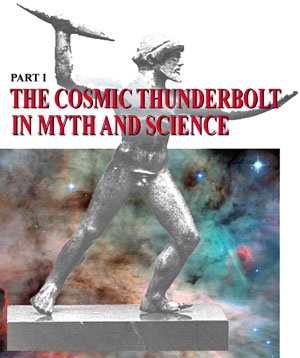





















 Alfven’s close colleague,
Anthony Peratt (image right), later extended his
investigation, conducting experiments with far-reaching implications
for the understanding of galaxies, stars, and the evolution of
planetary systems.
Alfven’s close colleague,
Anthony Peratt (image right), later extended his
investigation, conducting experiments with far-reaching implications
for the understanding of galaxies, stars, and the evolution of
planetary systems. 

